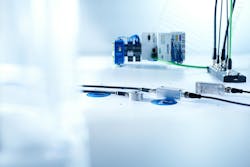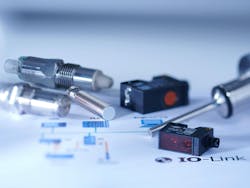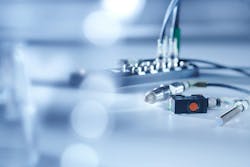Sensors collect and transmit a range of information which can be utilized to monitor a machine’s performance, potential maintenance needs and so much more. As they have become more digitized, the amount of data they can collect has increased, leading to not only smarter sensors but also smarter systems and machines.
This is enabling the transition to digitalization – the use of digital technologies to improve processes, services and more – which is taking place in various industries.
Power & Motion spoke with Kyle Lake, Product Market Manager SE-PR (process instruments) at Baumer Ltd., to get a better understanding of how sensor technology has evolved and the role it plays in digitalization.
*Editor’s Note: Questions and responses have been edited for clarity.
P&M: How have you seen sensor technology, particularly for digitalization, progress in recent years? What new features or capabilities have been brought to market?
KL: One of the biggest advantages of the new smart sensors is just in the commissioning of the sensors and/or machines. Because you can talk to them quicker, you have easier access to the information, you have more information to look at, [and] you can get [them] up and running faster.
In the case of the IO-Link, it could be something simple like the information about the sensor, once programmed, is stored on an IO-Link master. If a sensor is damaged and we need to hook up a new one, it automatically reprograms itself. So that means no more third shift stoppages, expensive staff on site all the time or an emergency call in to get someone there to hook up a new machine or hook up a new sensor and reprogram it.
And then with all the new information [from the sensors], we've been able to make the interface much more graphical. In the past, it was pots with a screwdriver and trying to guess ‘Did I turn it too much or not enough?’ Then we went to things like heart or touchscreen electronics to program. Now you plug in a USB cable and you can use your keyboard and mouse; it's a very straightforward way to do it. Some of our devices have web servers on the Ethernet IP devices [which] that could be done through. [It is] very graphical, feels like you're going to a website. Or it could be software that uses the IO-Link communication to program and do different things that way.
READ MORE - Understanding Digitalization and its Use in Fluid Power
P&M: What challenges yet exist with sensor technology, and how, if at all, is Baumer helping to overcome these with its own sensor products?
KL: The biggest challenge, and this is going to sound a little cliche because you hear it all time now, is just data. What data do we need to collect? What data do we not need to collect? And what do we do with the data?
We're trying to make sure that our sensors can provide as much raw data from the measurement itself and also the secondary data around it – the power consumption, running time, temperature spikes, dust buildup on lenses or any of those kinds of things. We have some that will monitor the light value that's being put out and give you a quality bit that says there's dust beginning to gather; [it shows] from green to yellow to red [to indicate] how it's affecting the reading.
[It’s not just about] giving you that data [and] access to the data locally, but then also how do you use that data, where do you take it. We're really working on making it accessible outside of the traditional process environment. Our new IO-Link masters have an OPC UA server built into them so you can actually export that information directly to some kind of spreadsheet, historian, whatever, gather that data and start to aggregate it and look through it and make it useful [so it is] not just numbers in a spreadsheet somewhere.
P&M: Related to the topic of data, is there certain types of data which customers are particularly interested in getting and is Baumer trying to tailor its technology to that?
KL: The quality bits are very important for customers. If it's a process that's in a dusty environment, they would like to know how often they have to clean their sensors, can they do some kind of air purge near the sensors to help clean them and keep up with [their cleanliness].
Power is another big one. People like to know how clean their power is and if they're seeing any power spikes. Power spikes aren't good for 24V devices, so if they're seeing big jumps [it could be a problem]. Ambient temperature is another one as well. If you get into high temperatures, it wears electronics quicker. So being able to see that kind of information [can be helpful]. The big buzzword is predictive maintenance – those all add data points to help you with that predictive maintenance. It's not going to do the maintenance, obviously, but it gives you some ideas and things to look at to build around [predicting maintenance needs].
READ MORE - Sensors and Software in Motion Control: Key Benefits to Consider
P&M: How do you foresee sensor technology for digitalization continuing to evolve in the coming years? What new technologies or features do you see entering the market or are yet needed to further advance digitalization?
KL: It's hard for me to picture where the digitalization of sensors is going to keep going. If you had asked me maybe 5 years ago, I would have thought a bigger, brighter touchscreen would have been the key or the future of digitization of the sensors. And I've come to find out, it's actually going to be all internal to the sensor.
We're going to keep getting more data out of the sensors. And again, that sounds cliche, but that's really what it's going to come down to. The next big step is going to be starting to interpret that data, and the software and the programs that will help with it.
When you buy a machine, will it come with a license that says we as the OEM can collect the data off the machine through a cloud and analyze what's going on with the machine and make maintenance recommendations and all those kinds of things? We've become such a subscription-based world, will you buy a warranty subscription [where] again, the OEM will monitor your machine remotely for you and you get $1,000 worth of sensors for the month, they send you those that look like they are wearing.
Or is it going to be artificial intelligence (AI) built into the sensor? With all these new data points, are we going to be able to put a brain in there and it self-adjusts to keep the measurement accurate and moving in the right direction?
I don't know, but whatever the next step is, it's going to include more data and faster communications, whether or not everybody needs it or wants it. That's kind of where I think it's going.





